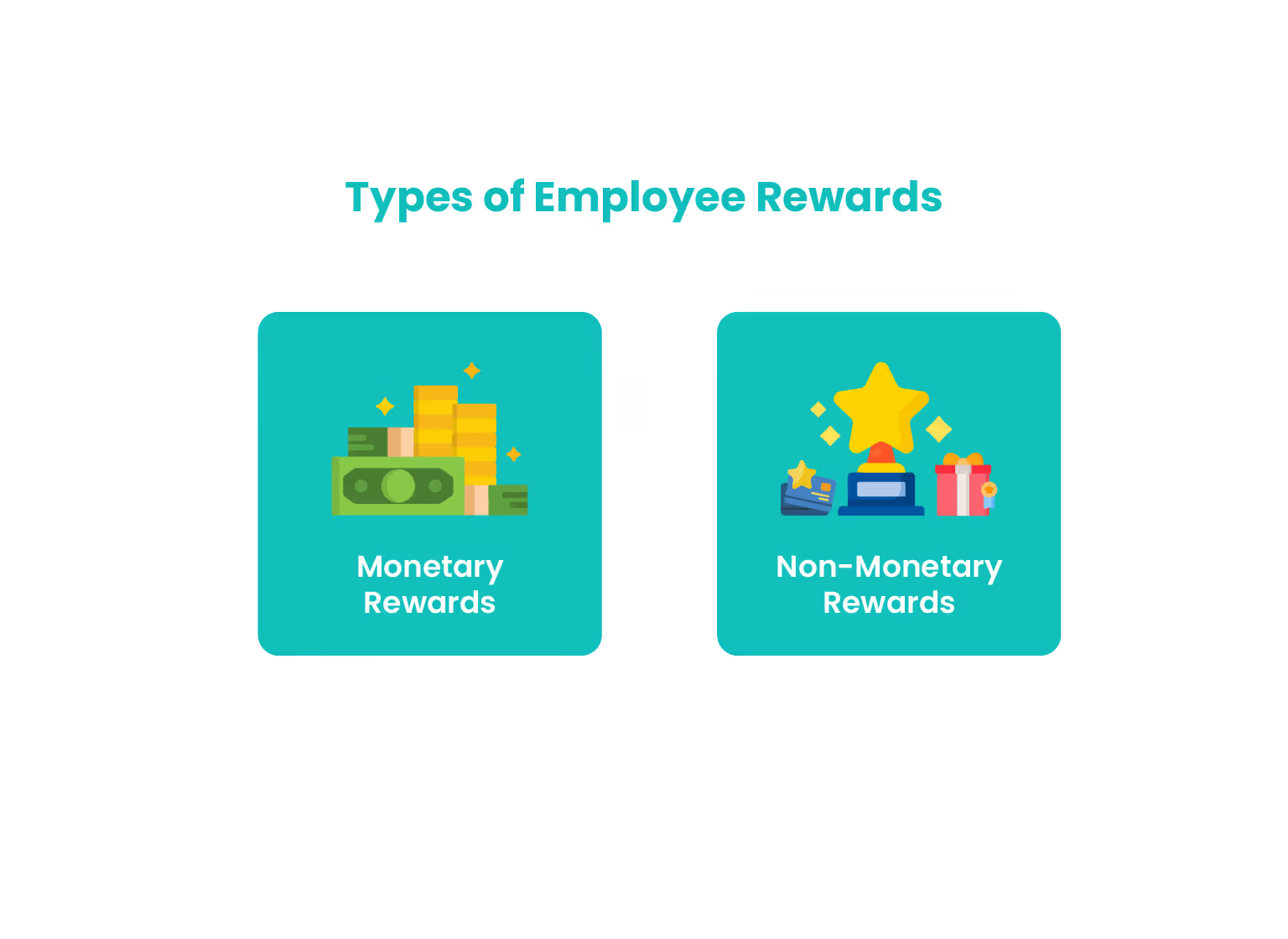
Blog
20 Effective Employee Incentive Programs to Motivate Employees
July 5, 2023


Key Insights
Let's raise a very basic question: How important is employee motivation?
Well, even with not much external influence, employees will turn up for their job and get their work done.
So why invest time and energy in thinking about employee motivation?
Stop right there! Never think in that line!
In an article titled U.S. Employee Engagement Needs a Rebound in 2023, Gallup found three interesting facts.
- There was a drop in engagement in young workers, women, and onsite workers looking for remote jobs.
- There was an increased phenomenon of quiet quitting among remote workers.
- There was a fall in clarity in job expectations.
What do these findings suggest to us? The importance, relevance, and priority of employee motivation in employee management.
But how do we achieve that goal?
Simple, a well-structured, planned, and executed employee incentive program.
This article takes you through a comprehensive understanding of employee incentives, their types, and 10 effective incentives to motivate employee performance.
So scroll down for more.
What are Employee Incentive Programs?
An employee incentive program, including various types of incentive compensation, is a motivational tool that ensures consistent performance and productivity of the workforce. It is a positive reinforcement that encourages employees to improve in their job, enhance employee engagement, and reduces turnover.
Through incentive programs, organizations create an employee-centered workspace and bring in best practices in them. It provides opportunities to grow, drives the workforce to achieve their goals, and recognizes them for their achievements.
What are the most common incentives?
Incentives can vary depending on the industry and individual preferences. So here are a few common effective incentives that are frequently used across organizations

- Performance Based Incentives
- Referral Programs Ideas
- MBO Bonus
- Profit Sharing
- Appraisal Cycle
- Recognition Programs
- Vacation Offers
- Paid Time Off
- Valuable Gifts
- Voucher Cards
- Tuition Reimbursement
- Employee Assistance Programs
- Team Events
- Stock Options
- Flexible Work Schedule
- Health and Wellness Programs
- Career Development Opportunities
- Company Retreats
- Discounts
- Verbal Recognition
Building an effective sales incentive program means choosing what suits your business model and employee preferences to maximize performance and bring out desired results.
Types of Employee Rewards?
Organizations incorporate various tools and techniques to boost employee motivation and keep their workforce up for any challenge.
Broadly employee rewards can be divided into monetary and non-monetary. Both these incentive forms have the capacity to push the employees to achieve their goals as well as strive to upskill for better performance.

What is the value of employee incentive programs?
Employee incentive programs play a crucial role in various areas of organizational management. From fostering motivation, and enhancing employee engagement to ensuring overall job satisfaction, incentives are integral for effective employee management.
It is only when employees feel valued through recognition and rewards that they will be encouraged to contribute towards individual and organizational success. It is a powerful tool for boosting employee morale, building a positive work environment, and enhancing performance, productivity, and loyalty.
Aligning incentives with set key performance indicators will help companies to ensure desired behavior and performance from their employees as well as timely achievement of set targets and quotas. It fosters a competitive work culture where employees are pushed to improve their performance consistency over the period.
Employee incentives are also ways companies retain their high-performing employees and attract top talents from the job market. As retaining employees is more cost-effective than hiring new candidates, an effective employee incentive program is a strategic investment toward economic business operations.
Employee incentives are also effective ways to track your team’s performance objectively. This helps identify the top performers to recognize and reward their efforts while providing necessary training and development for members who need improvement.
Hence, the value of an effective employee incentive program lies in motivating employees, retaining top talents, attracting high performers, building competitive workspaces, and enhancing overall operations. In simple words, it aligns individual success and achievement with the overall growth of the organization.

Monetary Rewards
These are variable pay in a salesperson’s salary that they receive upon achieving their sales quotas as part of the sales compensation plan. As these rewards are in the form of cash, salespersons can utilize them judiciously according to their better judgment, aided by a sophisticated sales commission calculator for accurate and transparent calculations.
Non-monetary Rewards
These are types of rewards that do not involve money but have a longer positive effect on the workforce. A paid leave, a vacation, or a word of appreciation can perform a greater feat in the employee’s performance, engagement, and confidence than any money can. Additionally, implementing effective training programs, such as those involving sales battlecards, can significantly contribute to employee skill development and motivation.
An ideal incentive program makes use of both monetary and non-monetary incentives, according to their organizational structure, agenda, budget, objectives, etc.
Knowing your organization and your employees' needs will help companies build a better incentive program.
For a more comprehensive understanding of how to motivate employees with incentives and to go about with incentive compensation, check Understanding the Basics of Sales Incentive Compensation
Now let’s delve into how these monetary and non-monetary incentives can be implemented in your company operations.

20 Effective Employee Incentive Programs
Now, let's delve into the various rewards for employees to motivate best practices and desired results.

Performance Based Incentives
Organizations can effectively motivate employees through rewards based on performance. With a set of metrics, KPIs, and an efficient sales performance tracker, companies can easily evaluate the productivity as well as the improvement achieved by their workforce. Based on these analytics, organizations can provide incentives to motivate employees' performance.
Referral Programs
Recruitment incentives for employees are an efficient way to engage the workforce in the hiring process. The policy considers your employee as a brand ambassador of the organization who uses their network to bring in the required skill set to the team. Along with monetary gain, it also brings a sense of belonging in the employee where their opinions and participation are valued.
MBO Bonus
In a Management by objectives model, both the manager and the employee are well aware of the set of goals to be achieved. Being a part of the goal-setting process helps the salesforce be better informed of their targets and prepare well to achieve their goals timely.
Profit Sharing
Incentive compensation is not always paid in cash. It can be in the form of profit sharing as well. Upon fulfilling their sales quotas, salesforce becomes eligible to get a portion of the profit. The profit share depends on the company policy and the agreement.
Appraisal Cycle
It's not always money that motivates employees. Some are looking for progress in work and positions. Hence, employee motivation programs can also take the form of appraisal where employees get promoted in their job, they get training to upskill their potential as well as be eligible for a yearly hike in salary.
Recognition Programs
Being recognized for your work and achievements is necessary for any employee to continue their strive for better performance and productivity. It creates a vigor in the workforce to work towards getting that validation and appreciation. In the end, who doesn't like a word of congratulation and a pat on the shoulder!
Vacation Offers
Many organizations also offer vacations as performance incentives for employees. It is of dual purpose. First, it motivates the employee to work hard, achieve their quotas, and be eligible for the offer. Second, the vacation gives time off from work where the employee can freshen up, get rejuvenated, and come back for better performance.
Paid Time Off
It is by law that every employee must be entitled to a fixed number of paid leave. Even though this rule exists, organizations must also encourage employees to avail their employee rights and take time off. It neither hinders their workflow nor interrupts everyday operations. Organizations use paid time off as a productivity incentive, encouraging employees to take breaks from work will only improve their productivity and the growth of the organization.
Valuable Gifts
Organizations reward their employees through various employee motivation programs. These days companies give valuable gifts like bikes, and electronic gadgets including mobile phones, laptops, etc. Getting these rewards is a great feat for any employee which will only improve their commitment and dedication to the work and organization.
Voucher Cards
Gift cards or voucher cards are another way to reward your employees with something memorable. As an equivalent of money, employees can go to particular stores to buy things of their interest. These initiatives give a sense of achievement as well as happiness in them.
Tuition Reimbursement
Tuition Reimbursement program supports employees while pursuing further education. Here the company covers the fees for the tuition under certain criteria. This encourages employees to upskill and develop themselves for better professional contributions.
Employee Assistance Programs
Employee Assistance Program is a well-being program that provides employees support services while facing any personal or professional challenges. This can be financial assistance, counseling, etc that assist them in overcoming the challenge.
Team Events
Team events mostly involve employee outings or other activities that drive team coordination and strengthen their bond. It is initiated to enhance teamwork, improve communication, and strengthen coordination within the organization.
Stock Options
Incentive stock options allow employees to buy a part of the company stock at a predetermined price. This helps align the financial interest of the employees with the business performance as well as imbibe a sense of ownership and belonging in the employees.
Flexible Work Schedule
Flexibility at work is a sort of incentive among employees. It allows them to work in flexible work hours and locations thereby ensuring work-life balance. It helps employees to focus on their individual preferences, enhance their job satisfaction, and ensure employee retention.
Health and Wellness Programs
Health and wellness programs focus on employee’s physical and mental health. This includes offering gym memberships, fitness classes, wellness workshops, and health insurance that helps them contribute better to their workforce.
Career Development Opportunities
Career development opportunities involve providing training and upskilling programs, attending workshops and mentorship sessions, sending them to foreign locations for client meetings, etc. These exposures help them enhance their skills, encourage continuous learning, and ensure professional growth.
Company Retreats
Company retreats involve offsite gatherings where employees meet for team building, strategic planning, and relaxation. It helps in strengthening the interpersonal relationships among team members and building positive work cultures
Discounts
Employee discounts offer company products or services to employees at a reduced rate. This encourages them to endorse the company products, provides value addition to employees, and creates a connection with the company.
Verbal Recognition
Verbal recognition is a form of recognizing and appreciating your employee's contributions and achievements in spoken words. Feeling acknowledged and appreciated in a public forum like a team meeting where the manager speaks highly of the employee's skill, dedication and contribution can have a huge positive impact on their work and reinforces positive behavior within the organization.
With a variety of tools and techniques available to keep the workforce motivated, organizations must use their creativity and strategy to make the best use of it.
To read more about the impact of incentives on productivity and its benefits, check Maximizing Productivity: Benefits of Employee Incentive Programs
What are common incentive mistakes?
Even with the best intentions, implementing employee incentive programs can sometimes fall flat. Several common mistakes can derail your efforts and prevent you from achieving the desired results. Being aware of these pitfalls is crucial for creating successful employee incentive programs.
- Launching Without Input: One of the biggest mistakes is launching employee incentive programs without first gathering input from your employees. What motivates one person might not motivate another. Understanding your team's preferences and desires is essential for designing effective employee incentive programs. Failing to do so can result in a program that no one engages with.
- Failing to Communicate or Be Consistent: A well-designed program is useless if no one knows about it. Clearly communicate the goals, rules, and rewards of your employee incentive programs. Consistency is also key. Don't launch a program with great fanfare and then let it fade away. Regularly remind employees about the program and celebrate their achievements.
- Being Inflexible: Employee incentive programs should be adaptable. What works for one team might not work for another, and what motivates employees today might not motivate them tomorrow. Be prepared to adjust your programs based on feedback and changing circumstances. Rigidity can make your employee incentive programs ineffective.
- Offering One Type of Reward: People are motivated by different things. Offering only one type of reward, such as monetary bonuses, can exclude employees who are motivated by other incentives, like recognition or experiences. A diverse range of rewards within your employee incentive programs will cater to a wider range of preferences.
- Lack of Alignment with Business Objectives: Employee incentive programs should align with your overall business objectives. If your goal is to increase sales, your incentive program should reward sales performance. A disconnect between your incentives and your business goals will dilute the impact of your employee incentive programs.
- Overcomplicating the Plan: A complex and confusing incentive program is likely to fail. Keep your programs simple and easy to understand. Employees should be able to easily see how they can earn rewards. Overcomplication can lead to confusion and disengagement with your employee incentive programs.
- Setting Unrealistic Targets: Setting targets that are too difficult to achieve can discourage employees. They may feel that the rewards are out of reach and lose motivation. Targets should be challenging but attainable. Unrealistic targets can undermine the effectiveness of your employee incentive programs.
- Neglecting Regular Review and Adaptation: Employee incentive programs should not be a "set it and forget it" endeavor. Regularly review your programs to ensure they are still effective and meeting your objectives. Be prepared to adapt and make changes as needed. Neglecting review can lead to outdated and ineffective employee incentive programs.
- Lack of Transparency and Clarity: Transparency is crucial for building trust in your employee incentive programs. Clearly communicate how performance is measured and how rewards are earned. Any hint of unfairness or lack of clarity can damage trust and undermine the program. Lack of transparency can breed resentment and distrust, harming your employee incentive programs.
- Failure to Track and Measure Performance: You need to track and measure the performance of your employee incentive programs to determine their effectiveness. This data will help you make informed decisions about future programs. Without tracking and measurement, you won't know if your employee incentive programs are working.
5 Best Practices for Employee Incentive Programs
Implementing employee incentive programs is not enough to ensure the effective execution of the program to bring in desired results. It must also be complemented by best practices that ensure and enhance its effectiveness.
Here are 5 best practices for your employee incentive program.

Clear Objectives
Clearly define the objectives of your employee incentive program and align it with the overall business goals. This ensures that there is clarity among employees as to what is expected of them and how to achieve their goals to be eligible for their incentives.
Fair and Transparent Criteria
Employee incentive programs must be set with clear criteria to evaluate employee performance and measure their progress. These criteria must be sent fairly so that your employees can achieve them and transparently communicate to ensure their effectiveness in bringing desired outcomes.
Customization
Tailor your employee incentive program to ensure that it fits the diverse needs, caliber, and preferences of your employees. Personalizing the incentives depending on each employee will enhance its effectiveness as each employee is working towards what they need the most.
For example, if you are a company with a substantial number of remote employees, incorporating ideas for rewarding remote employees will help enhance your work culture.
Frequent Communication
Employees must be communicated about all aspects of the employee incentive program. The incentive criteria, the progress made by each employee, and the updates made to the incentive program must be communicated to ensure motivation and engagement.
Performance Measurement
Setting an employee incentive program is not a one-time process. It must be regularly cross-checked to ensure its effectiveness. This involves taking feedback from employees on the effectiveness of the program in bringing the desired results and its relevance with the changing company objectives.
Taking care of these minute details will help improve the effectiveness of your employee incentive program and bring in the desired and expected results.
9 Benefits of employee incentive program
- Incentive programs are powerful tools for employee motivation by recognizing employee efforts and rewarding their achievements.
- Employee incentives encourage employees to consistently improve their performance and productivity.
- When employees feel recognized for their efforts and contributions it improves their engagement and fosters a sense of belonging.
- A well-designed and effective employee incentive program ensures higher retention rates as well as attracts top talents to the organization.
- Incentive programs also help effectively align individual goals and targets with the overall company objectives.
- Effective employee incentive programs successfully create a healthy, positive, and competitive work culture that motivates employees to improve themselves.
- Employee incentives incorporate key performance indicators to assess employee performance making the evaluation process objective and unbiased.
- Incentive programs provide insightful feedback on employee performance, highlighting their strengths and suggesting areas of improvement.
- An effective employee incentive program motivates its employees to improve while ensuring engagement and commitment.
Conclusion
Big or small, recognitions and rewards are valuable in an employee's career and compulsory in an organization.
Organizations must create an environment where employees are celebrated and appreciated for all their milestones. Rewards have a huge impact on their motivation, focus, commitment, dedication, engagement, participation, confidence, sense of belonging, and many more.
Efficiently tracking their performance and managing their incentives helps companies make a huge difference in organizational growth and employee wellbeing. These days digital tools have made this crucial task seamless.
Kennect supports organizations in incentive compensation management and sales performance management through automation to create transparency and achieve operational efficiency. For more information, Book A Demo Now!
ReKennect : Stay ahead of the curve!
Subscribe to our bi-weekly newsletter packed with latest trends and insights on incentives.
Thank you! Your submission has been received!
Oops! Something went wrong while submitting the form.
Your data is in safe hands. Check out our Privacy policy for more info




.avif)


.avif)







